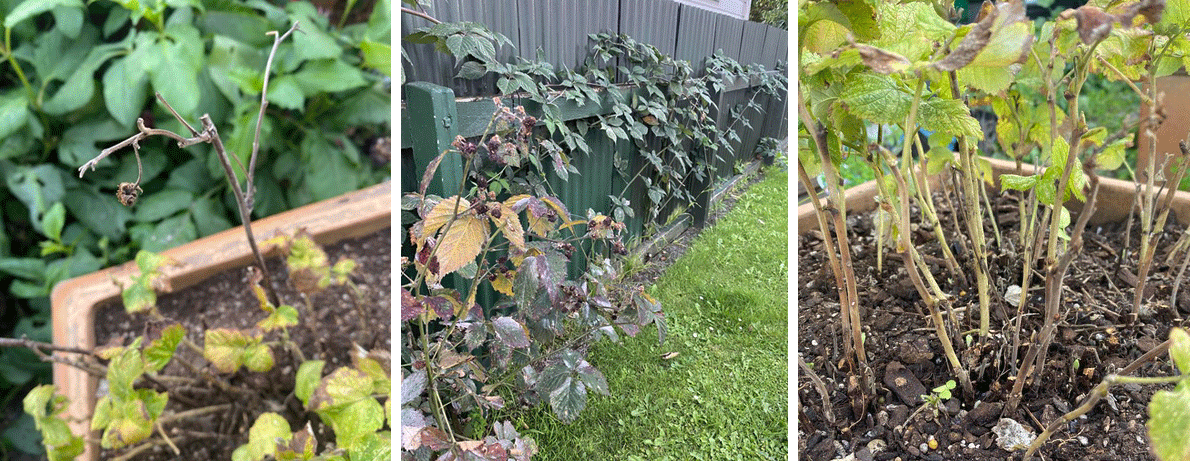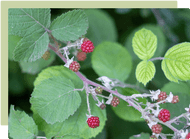Posted by Kelly Jean Reyland
9th May 2024
Pruning berry fruit for healthy plants and big crops

One job that we should never brush off as unimportant - particularly for fruiting plants and trees - is pruning. Why do we prune? We prune for health, for size, for beauty, for harvest and for pleasure. So yes, it’s quite important! In this blog we look at berry fruit specifically.
At the very basic level, pruning lets in air and light and removes dead, dying or diseased branches. This helps improve the overall health of the plant and reduces the chance of diseases. Anyone who has seen an ignored raspberry bush will understand how crowded they can become, and we have all seen blackberries and brambles smothering other plants on the side of the road, left to their own devices.
More specifically for fruiting plants, pruning helps to remove branches that will no longer fruit and are simply diverting energy from fruit production. It enables us to control the number of fruit (thinning) which improves the size and sweetness of the remaining fruit. Removing excess stems and branches also enables the maximum amount of sunlight into the plant or tree which is converted into food for the plant.
The vital piece of information you need before pruning your berry plant is what year wood does the plant produce its fruit on.
What does that mean?
- First year wood means the fruit will only develop on new growth from this spring, e.g. blueberries, double fruiting / everbearing raspberries - summer harvest
- Second year wood means the fruit will develop on wood that grew last spring, e.g. blackberries / brambles, currants, black currants, raspberries - single harvest, double fruiting (everbearing) raspberries – fall harvest
- Third year wood means the fruit will develop on wood that grew in spring two years ago, e.g. currants
Pruning
It’s pruning time (after you make sure your secateurs are sharp and clean!). It's good practice to start by removing the 3 D’s: dead, dying or diseased. This will simplify your job going forward...
Blackberries/brambles - Fruiting on second year wood, the long canes will die after fruiting, leaving a strong bud at the base of the dead cane or a completely new shoot from the base. Cut the cane back to the bud or remove completely if there is a new shoot from the base. Do this when they are dormant. Also remove excess new canes, leaving only six or so of the sturdiest and healthiest canes. Grow them against a support frame to enable control of the shape, enable easy pruning and easily access the fruit. Shorten the new canes to encourage side shoots which will fruit next spring.
To help make pruning simple, you can train the first-year canes (next year's fruiting canes) in one direction along a trellis and have the fruiting canes trained in the other direction. At the end of the fruiting season, you can remove all those fruited canes, leaving room for the new canes.
Blueberries - Fruiting on first year wood, in the first three years, the only pruning they need is removing dead and diseased wood. Highbush varieties will keep growing new stems / branches for 6 years, so the first step is to remove any stems more than six years old. After that trim back young or spindly stems to strong branches or buds and remove older twiggy growth. Rabbiteye varieties are more vigorous growers than high bush so prune them similarly but don’t cut them back too hard to avoid stimulating excessive growth.
Black currants - They bear their best fruit on second year wood so when they are dormant remove the stems that have fruited, right to the ground or to a low, strong side shoot that will grow a new stem. Thin out one-year stems to the ground, leaving just 6 of the strongest, upright stems, to avoid crowding.
Raspberries (single harvest varieties) - Simply remove the canes that fruited this season and leave the new canes to fruit next season. You can usually see where the berries have been attached or by the colour. The canes to remove are matte brown/grey. The canes to leave are green/brown. Double harvest varieties - These fruit at the tips of first year canes in late summer and autumn. These same canes will fruit the following season in early summer lower down the cane. You can remove the tips after they fruit the first time, leaving the lower cane to fruit again. After the second harvest lower down on the canes, remove the entire cane from the base. Leave the first-year canes.
There are few foods that compare to the taste of homegrown, sun-ripened berries. Grow your own and as you learn how to care for them you will enjoy many years of delicious berries!
Written for Gubba by Kelly Jean Reyland from Garden Advice NZ (www.gardenadvice.co.nz)


























